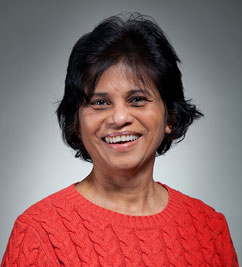With WCER Connection, Wisconsin Teachers Learn from Finland’s Education System
February 5, 2015

Sadhana Puntambekar
Four Wisconsin educators – two UW-Madison researchers and two K-12 science teachers – got the opportunity of a lifetime this fall when they received a behind-the-scenes tour of Finland’s education system, which is often rated among the best in the world.
Greg Sonsalla, a sixth grade science teacher at the Glacial Drumlin Middle School in the Monona Grove School District, and Waunakee Middle School eighth grade science teacher Jessica North spent five days in September in Finland, touring schools and a teaching college. Sonsalla and North traveled to Finland with Dana Gnesdilow, who works in Sadhana Puntambekar’s Interactive Learning and Design Lab, which is located in the Wisconsin Center for Education Research.
“It was the journey of a lifetime, an amazing experience,” Sonsalla said. “Even though we were only there five days, we brought back knowledge with us that will hopefully create major positive changes in our classrooms and schools.”
The team sought to learn as much as possible about Finland’s highly touted education system as they could during their short time there. Finnish children don’t begin school until age seven, school days are shorter than in the U.S., and students get 15-minute breaks between classes, they noted. Students learn English and Swedish, in addition to Finnish, starting from their equivalent of third grade. And there is no standardized testing in Finland.
In addition, qualifications to become a teacher are higher, with all teachers required to go through a five-year, master’s level program to earn certification, and the student-to-teacher ratio is much lower than in the U.S. Teachers are each given their own offices inside their schools, and are supported with ample classroom technology such as computers, Smartboards and Active Tables, North said.
“It was impressive, but I came away feeling pretty good about what we’re doing in my school district back in Wisconsin,” North said. “We have similar ideas as our Finnish counterparts of what a classroom should look and feel like. As far as teaching quality is concerned, I think Waunakee is on the level of the top education system in the world.”
Sonsalla had a similar feeling of justification of his own practices upon his return, saying that his work with Puntambekar’s project had pushed his teaching beyond what is offered in some of the classrooms he observed in Finland.
“It reaffirmed the work we’re doing at my school, because a lot of what I saw over there is an old-fashioned approach to teaching, with teachers dispensing knowledge and students copying it down in their notebooks,” Sonsalla said. “The main difference I noted in Finland was the overwhelming respect that everyone has for their schools and teachers. And the feeling of school community was a bit different – I saw things like teachers eating lunch with their students.”
Puntambekar’s work on creating dynamic digital texts – and the funding for the educators’ trip to Finland – came from the National Science Foundation’s Science Across Virtual Institutes (SAVI) project, which aims to incorporate better digital design into e-textbooks to improve student navigation and interaction. Collaboration with researchers in Finland is a key component of the project, according to Puntambekar.
“We’re testing its theoretical framework for dynamic digital texts with content in science and computing, for middle school and college, in Finnish and English,” she said. “As we work jointly to create these texts, working in two countries and two languages helps us systematically evaluate their use and utility across multiple content domains, learner levels and cultures.”
As part of the SAVI project, Sonsalla and North were invited to give presentations on their experiences implementing the e-textbook in their classrooms at the teacher’s colleges at the University of Turku and the University of Tampere. Sonsalla said they found their audiences eager for their perspectives and welcoming of their calls for a reinvented approach to classroom teaching.
“Our talks were mainly about embracing and working with kids’ natural curiosity,” Sonsalla said. “We’ve found that by middle school, a lot of kids have been forced to follow procedures and this molds how work is done in the classroom, and that just kills their curiosity. By getting out of a lecturing-first mindset and allowing kids to play around with this new technology, it really flips that light bulb back on, and as they realize they have some control over their approach and journey, it reengages their creativity.”
For Puntambekar, observing the exchange that has taken place between the American teachers and their Finnish counterparts has been inspiring, and one of many reasons why she will seek further funding to continue the collaboration, when the current round of funding ends.
“Everything about the collaboration has worked so well,” she said. “It’s one of those projects you never want to end.”


